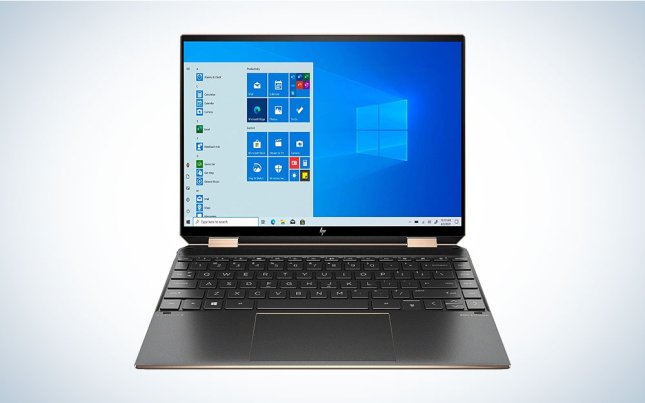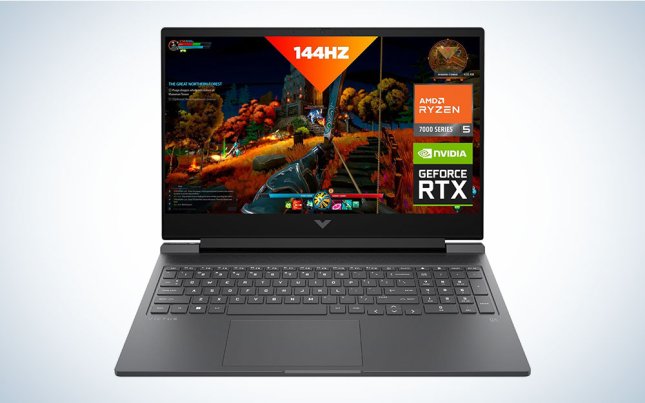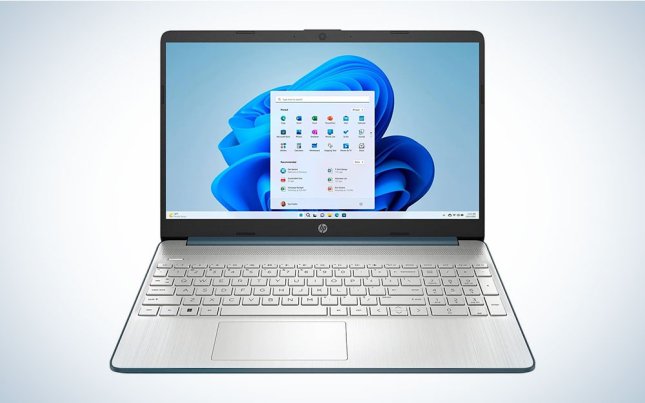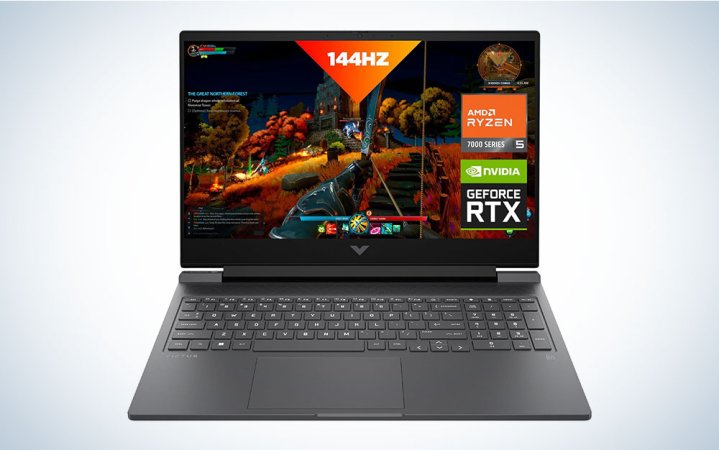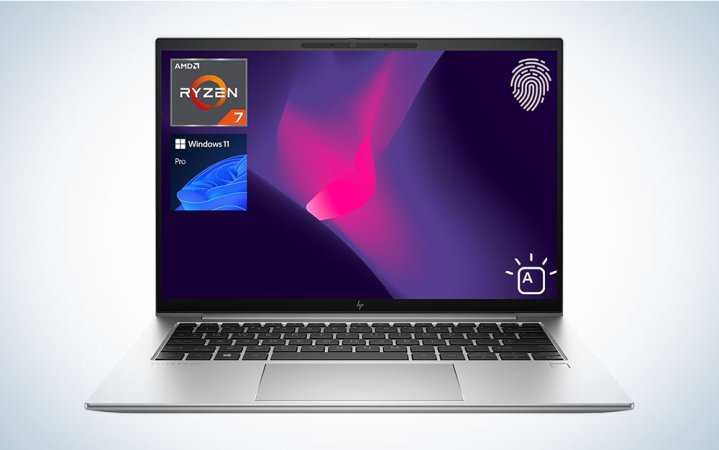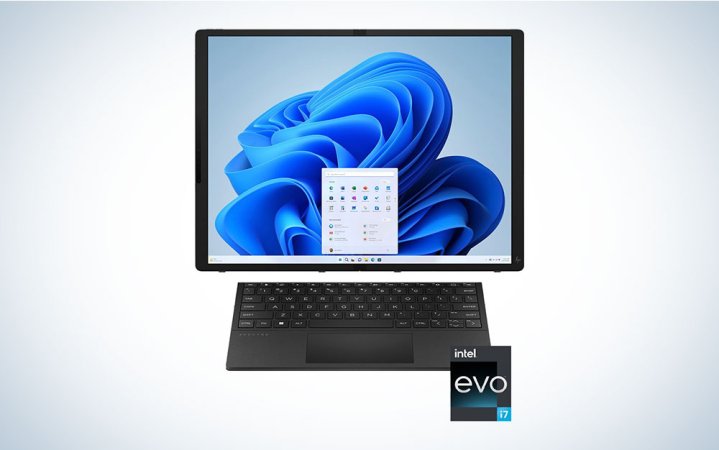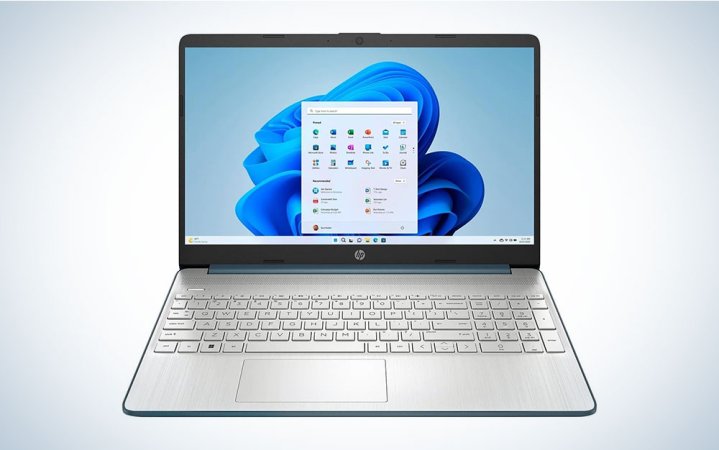We may earn revenue from the products available on this page and participate in affiliate programs. Learn more ›
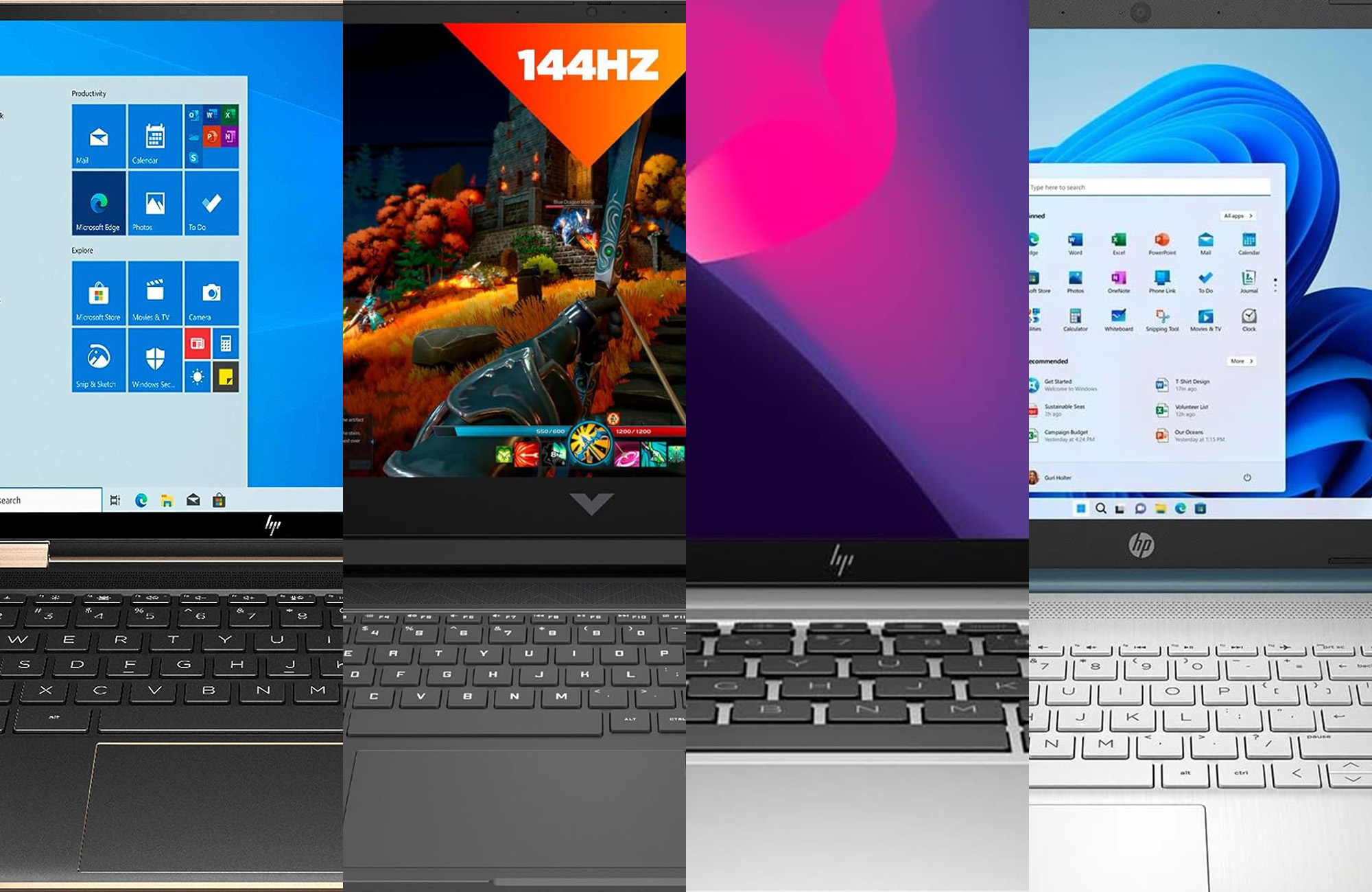
Choosing an HP laptop can be like going to the grocery store hungry: The company aims to have an option for every flavor of computing, but its many offerings can lead to frustrating indecision. The upside of HP’s variety is that there’s something on the menu to satisfy your tastes, whether you’re salivating for a tablet/laptop hybrid, a good gaming experience, an executive-worthy business machine, or a need to stick to a tight budget. This roundup features some of our favorites and advice to help you find the best HP laptop.
- Best overall: HP Spectre x360 Luxury 14T
- Best Chromebook: HP Dragonfly Pro Chromebook
- Best 2-in-1: HP Envy 2-in-1 14” Full HD Touch-Screen Laptop
- Best for gaming: HP Victus 16 Laptop
- Best for business: HP EliteBook 845 G9 Business Laptop
- Best with a folding screen: HP Spectre 3-in-1 17″ 2.5K OLED Touch-Screen Foldable Laptop
- Best budget under $500: HP 2023 15.6 inch HD Lightweight Laptop
How we chose the best HP laptops
We are nerds with opinions—a redundant statement—who pulled from firsthand experience with various laptop types and dove deep into our own PopSci reviews, peer suggestions, critical reviews, and user testimonials to chop the options down for you.
The best HP laptops: Reviews & Recommendations
There’s one word to describe the HP laptop lineup: overwhelming. This well-regarded and established brand has about a dozen different brand names for laptops with additional models within them–and that’s without considering the back catalog of older but still good offerings. The sheer number of possibilities can make you want to give up before you truly start the search, so here’s some help navigating the recent models.
HP’s premium lineups include the Spectre and Envy brands, which focus on lightweight, attractive designs and have the price tags to match. For strictly business needs, consider the Elite Dragonfly and EliteBook models’ strong performance and durable designs. The Omen and Victus lines focus on delivering value gaming laptops. When hunting for good value, consider budget-friendly lines, such as the Pavilion, Steam, Notebook, and Chromebooks. Despite the many names, the brands overlap and share common features. Many laptops have speaker systems by Bang & Olufsen, backlit keyboards, and security features like physical camera shutters and fingerprint readers. Many HP devices—whether they’re laptops or a 2-in-1 device—embrace touchscreens. Using fingers or a pen can seriously boost productivity, though it results in a smudgy mess to deal with before watching a bunch of videos. Maybe it’s just my OCD talking, but you may want to refresh how to clean a computer screen.
Best overall: HP Spectre x360 Luxury 14T
Specs
- Dimensions: 11.75 inches by 8.67 inches by 0.67 inches
- Weight: 2.95 pounds
- OS: Windows 11 Pro
- RAM: 16GB DDR4 SDRAM
- Storage: 512GB NVME SSD
- Processor: Intel Core i7-1165G7 (11th generation)
- Graphics: Intel Iris Xe Graphics
- Screen size: 13.5 inches
- Resolution: 1920 x 1280
Pros
- Lightweight
- Can be used as laptop or tablet
- Physical camera shutter
- Backlit keyboard
- Includes pen
Cons
- Pricey
- Older generation processor
- Low port variety with 2 Thunderbolt 4s, headphone jack, and microSD card slot
At under three pounds, the HP Spectre x360i ha Luxury 14T offers an ultraportable hybrid device that can be an elegant laptop or a tablet with an included rechargeable MPP2.0 Tilt Pen. With one of the best touchscreens of the bunch, its full high-definition screen provides a crisp, colorful picture at 400 nits, while Bang & Olufsen quad speakers supply the sound. Though it doesn’t have a ton of ports, the HP Spectre x360 Luxury features two Thunderbolt 4 ports with seemingly hidden power. The ports are compatible with USB-C 4, which supports power delivery and display protocols like DisplayPort and HDMI 2.0, so you’re not sacrificing the ability to connect a screen or monitor despite the lack of dedicated ports.
Best Chromebook: HP Dragonfly Pro Chromebook
Specs
- Dimensions: 12.4 inches by 8.7 inches by 0.7 inches
- Weight: 3.33 pounds
- OS: Chrome OS
- RAM: 16GB LPDDR5-5200 MHz RAM
- Storage: 256GB PCIe NVMe M.2 SSD
- Processor: Intel Core i5-1235U (12th Generation)
- Graphics: Intel Iris Xe
- Screen size: 14-inch touchscreen
- Resolution: 2560 x 1600
Pros
- Bright screen
- Great speakers
- 8MP webcam
- Backlit keyboard
- Fingerprint reader
- Comes in white or black
Cons
- No headphone jack
- Few ports
- Pricey for a Chromebook
The HP Dragonfly Pro Chromebook is for anyone seeking a higher-end Chromebook experience, not a bargain basement deal. For about a grand, this option suits users who prefer the Chrome OS, live in Google Suite and web browsers, and embrace cloud storage. It’s packed with a four-speaker Bang & Olufsen speaker system and an 8MP webcam for better video conferencing and media streaming. The shining star of the Dragonfly Pro Chromebook is the 14-inch touchscreen with a 2560 x 1660 resolution and up to 1,200 nits of brightness. That’s about three to four times brighter than most average laptops, resulting in a crisp, colorful viewing experience. It’s the kind of screen you can read in the sunshine, but keeping it on at full power can also be a severe battery drain. Though HP boasts more than 11 hours of battery life, users report falling short of that.
Another thing to consider is that even the best Chromebooks have less processing power and storage than a middle-of-the-road laptop. The Dragonfly Pro Chromebook features decent storage (256GB solid-state drive) and mid-level processing (an Intel i5) but only has four Thunderbolt ports and no headphone jack. Plan on getting a USB-C hub for peripherals and one of our best Bluetooth headphones.
Best 2-in-1: HP Envy 2-in-1 14” Full HD Touch-Screen Laptop
Specs
- Dimensions: 12.68 inches by 8.3 inches by 0.77 inches
- Weight: 3.35 pounds
- OS: Windows 11 Home
- RAM: 8-16GB
- Storage: 512GB-1TB PCIe SSD
- Processor: Intel Core i5-1335U (13th Generation) or Intel Core i7-1355U (13th generation)
- Graphics: Intel Iris Xe Graphics
- Screen size: 14-inch touchscreen
- Resolution: 1920 x 1080
Pros
- Configurable
- Can be used as laptop or tablet
- Fingerprint reader
- Physical camera shutter
Cons
- Heavier than a traditional tablet
- Compatible pen not included
Sometimes, the combination of ingredients is what makes a product. Would a Sprite be delicious without lemon and lime? Doubtful. HP has long made some of the best 2-in-1 laptops, and the HP Envy 2-in-1 14” Full HD Touch-Screen Laptop is a particularly delicious version of a laptop that converts into a tablet for writing on it with a compatible pen or setting it up for a Netflix binge sesh. The 14-inch model is bulkier than a traditional tablet but still, an easily portable device weighing just over three pounds. The entry-level 8GB RAM, 512GB storage, and a 13th generation Intel Core i5 processor is a respectable machine for multitasking and even casual gaming, but you can double the RAM and storage and up the processing power to the Intel Core i7 for about $200. That boost makes for better media creation and more demanding applications and is one of the best for students or other folks who go back and forth between typing on a keyboard and watching videos.
Best for gaming: HP Victus 16 Laptop
Specs
- Dimensions: 14.53 inches by 10.21 inches by 0.9 inches
- Weight: 5.07 pounds
- OS: Windows 11 Home
- RAM: 16GB DDR5-5200 MHz RAM
- Storage: 512GB PCIe Gen4 NVMe TLC M.2 SSD
- Processor: AMD Ryzen 5 7640HS
- Graphics: NVIDIA GeForce RTX 3050
- Screen size: 16.1 inches
- Resolution: 1920 x 1080
Pros
- Higher screen refresh rate
- Good keyboard with full numeric pad
- Good ports with 1 USB-C, 2 USB-As, HDMI 2.1, RJ-45, headphone jack
Cons
- Heavy for a laptop
- Average battery life
- Could use more robust speakers
Most gaming laptops scream what they are with colorful glowing logos and more vents than an HVAC system. The HP Victus 16 Laptop isn’t that. The understated black laptop offers a good entry point for the budding gamer with an AMD Ryzen 5 processor and NVIDIA GeForce RTX 3050 graphics unit. The screen’s 144Hz refresh rate helps smooth out motion, leading to a visually more pleasant experience than trying to game on a standard laptop. The Victus 16 also sports a full numeric keypad and a decent selection of ports, including an HDMI 2.1 port for connecting a gaming monitor. At more than five pounds, the Victus 16 is heavy, a common gripe for gaming laptops and the substantial cooling systems they need to offset the processing. If you’re aiming for e-sports domination, though, you might need to spend more on something from a dedicated gaming brand.
Best for business: HP EliteBook 845 G9 Business Laptop
Specs
- Dimensions: 12.42 inches by 8.72 inches by 0.76 inches
- Weight: 3.09 pounds
- OS: Windows 11 Pro
- RAM: 32-64GB DDR5 SDRAM
- Storage: 512GB-2TB PCIe NVMe M.2 SSD
- Processor: AMD Ryzen 7 PRO 6850U Processor
- Graphics: AMD Radeon Graphics
- Screen size: 14 inches
- Resolution: 1920 x 1200
Pros
- Customizable
- Bright screen
- Backlit keyboard
- Fingerprint reader
- Excellent port selection with 2 SuperSpeed USB-As, 2 SuperSpeed USB-Cs, HDMI 2.1, smart card reader, headphone jack
Cons
- Higher resolution screen option would be nice
The HP EliteBook 845 G9 Business Laptop includes features like a fingerprint reader and a long battery life that make the workday a little friendlier, making it one of the best for working from home or a remote locale. We like the 14-inch screen and weight of close to three pounds for easy travel and sliding in and out of a laptop bag. The screen features an impressive 400 nits—a bright screen, but we’d love to see a higher resolution available to help avoid spreadsheet bleariness. The EliteBook’s guts can be customized from 32GB to 64GB of RAM and storage ranging from 512GB to 2TB, ample speed, and space for crunching and manipulating large files. The best business laptops have an impressive variety of ports for whatever you need to plug in, whether it’s an HP monitor or a home office printer, and the EliteBook 845 checks this box, too, with SuperSpeed versions of USBs for the fastest transfers possible.
Best with a folding screen: HP Spectre 3-in-1 17″ 2.5K OLED Touch-Screen Foldable Laptop
Specs
- Dimensions: 10.91 inches by 7.53 inches by 0.84 inches
- Weight: 3.58 pounds
- OS: Windows 11
- RAM: 16 GB LPDDR5-5200 MHz RAM
- Storage: 1 TB PCIe Gen4 NVMe M.2 SSD
- Processor: Intel Core i7-1250U Evo Platform (12th generation)
- Graphics: Intel Iris Xe Graphics
- Screen size: 17 inches
- Resolution: 2560 x 1920
Pros
- Allows for multiple screen and keyboard configurations
- Includes wireless pen, USB-C hub, keyboard charging cable
- OLED display
Cons
- Expensive
- Webcam position changes depending on the configuration
- How well folding screens age is still TBD
Some devices like to challenge the very form personal computing takes, and the HP Spectre 3-in-1 17″ 2.5K OLED Touch-Screen Foldable Laptop is one of those puzzles. Is it a laptop? A tablet? A portable desktop? According to HP, it’s all three. If you love playing with Transformers or are a die-hard gadget geek, this might be your laptop.
The Spectre Fold has multiple pieces: a foldable tablet measuring 17 inches on the diagonal, a keyboard, and a wireless pen. You could use just the big ol’ tablet with the pen or open the built-in kickstand to use it as a large display for the keyboard (aka, a portable desktop mode). But you can also fold the tablet and screen together to make a traditional laptop with a 12.3-inch diagonal display. Feeling crazy? Slide the magnetic keyboard down to have another half-screen below the fold. New windows-snapping tools help arrange workspaces in nontraditional shapes. It’s flexible enough that you may find yourself rearranging your computer to fit your work rather than trying to make your work fit on your computer. And you get the benefit of an OLED screen’s true blacks, rich colors, and impressive contrast. However, one weird thing is that the webcam can be on the screen’s top or side, depending on the configuration.
At about $5,000, it’s a serious chunk of change to splash out for tech with some serious questions. How well will the folding screen age? Will it crease with time and use? Folding screens are still a novelty in the real world, and their durability is still being tested.
Best budget under $500: HP 2023 15.6 inch HD Lightweight Laptop
Specs
- Dimensions: 14.11 inches by 9.53 inches by 0.71 inches
- Weight: 3.75 pounds
- OS: Windows 11 Home in S Mode
- RAM: 12GB DDR4 RAM
- Storage: 512GB PCle SSD
- Processor: Intel Core i3-1125G4 (11th generation)
- Graphics: Intel UHD Graphics
- Screen size: 15.6 inches
- Resolution: 1366 x 768
Pros
- Inexpensive
- Good storage for price
- Backlit keyboard
- Good ports with 2 SuperSpeed USB-A, 1 USB-C, HDMI, SD card reader and headphone jack
Cons
- Entry-level graphics card
- Older processor
Navigating the sub-$500 laptop market can be tricky, but a savvy buyer should focus on getting as much processing power and storage as possible. The HP 2023 15.6 inch HD Lightweight Laptop offers a lot to like. The entry-level Intel i3 processor is a couple of generations behind, but it’s still suitable for most everyday tasks and computing needs. For the price range, this laptop features decent RAM and storage to support multitasking and some photo and video editing. It has a decent anti-glare, high-definition screen that’s large enough for comfortably falling into a YouTube rabbit hole, though won’t be the crispest or brightest screen on the market. It’s a solid performer and a good fit for anyone who wants to avoid overpaying for processing power they don’t need.
What to consider when buying the best HP laptops
It’s tempting to max out specs and call your search over, but that’s like buying a luxury car when all you’re trying to do is have a reliable car to go back and forth to work. Start with how you plan on using your machine and finding the best match within your budget.
Price
If only price wasn’t an object—but it is. It’s possible to get a laptop for under $500, but you’re making tradeoffs in power, speed, and display quality. Reliable laptops that can handle basic computing tasks like web browsing, school work, or home office-type tasks can be bought for $600 to $800. Expect to spend at least $1,000 or more for the kind of processing power and memory needed for creative work like editing photos or videos, or entry-level gaming. The more powerful the laptop, the more it will cost. Innovative features like new form factors or premium touches like aluminum instead of plastic can also increase the price. HP frequently rotates which laptops are on sale, so deal-watchers can likely find a model they’re coveting for a steal.
Processing power, memory, and storage
Once upon a time, you could buy a computer that met your needs at the moment but could be upgraded later. Manufacturers have moved away from upgrades after purchase, so think carefully about how much memory and storage you may need.
Processors—usually Intel or AMD in Windows machines—are your laptop’s brain. To ensure more processing power, look for more cores, higher GHz, and the newest generations. Get as much as you can afford. RAM affects multitasking performance. For basic computing, 8GB will do, but consider 16GB or more if you use many creative apps, coding, or gaming. Solid-state drives have essentially replaced slower, mechanical hard drives to benefit content creators and gamers who need speed. We like at least 512GB of storage, though of all the specs, this can be most easily addressed after purchase with external drives.
Graphics processing units display the data the CPU processes, and higher-end GPUs can display higher-fidelity graphics, something to consider if you’re gaming or editing and processing video. The flip side is that GPUs use more power and can drink the battery juice.
Display
Displays do more than look pretty, but looking pretty is a good start. Size is a prominent factor in determining how many windows you can fit on a screen, but you also want to consider a higher resolution. The higher the resolution, the sharper the screen will look, and the more details you’ll be able to see. Brightness is another factor to consider, especially if you work in a bright room or attempt to work outside on sunny days. Screen brightness is measured in nits, and can range from 200 up to 1,200. However, using a screen at full brightness is another battery drain.
Gamers will also want to consider a screen’s refresh rates, aka how fast it can update what’s happening per second. Refresh rates can range from 30Hz to 300Hz, but you’ll most commonly see 60Hz, 144Hz, and 240Hz. We recommend at least 140Hz for AAA gaming.
Portability
Size + weight = how portable a laptop is. We like a 13 to 15-inch screen and a computer that’s three pounds or lighter device for people who want to lug laptops all around town. Five pounds may not sound like much until it’s been on your back for eight hours, but that’s about the heaviest laptop to consider for carrying around regularly. Of course, plenty of users have laptops that always stay on their desks. Bigger laptops with 16- and 17-inch displays may be heavier but grant crucial inches of screen space. Gaming laptops come packed with processing power and cooling systems, making them bulkier than other options.
Ports
Always check the ports built-in to a laptop so you can see how you can augment your computing setup. Consider the monitors, cameras, mics, audio interfaces, and other equipment you want to connect. USB-C ports are edging out USB-A as the default choice for peripherals, but not all USB-C ports and cords are equal. Some transfer only power and data, while others support video protocols that replace the need for an HDMI port. How will you know? Read carefully.
FAQs
The Hewlett-Packard company has been around for a long time, opting to offer a wide range of laptops for any kind of user, not a particular niche. The result is a lineup with a broad price range and different caliber components. Don’t just buy an HP label; take the time to study the laptop model to make sure it meets your needs.
Laptops in the sub-$500 price range typically come equipped with modest processors and storage capacities. We’ve done our homework on the best laptops under $500, and these budget-friendly options usually offer 4-8GB of RAM and 64-256GB of storage, making them suited for less demanding tasks such as web browsing, streaming, word processing, and, occasionally, light photo editing. It’s easy to outgrow the processing power and storage when the bar is set lower to start.
The laptop’s longevity is affected by how you use and handle it. A laptop used primarily for occasional web browsing can perform well longer than one subjected to intensive use or extensive travel. Has your laptop ever felt hot? That’s a sign you’re pushing your machines to their limits, or it has a crap cooling system, or both.
The typical lifespan of a laptop is expected to be around three to five years. In general, high-end laptops boasting advanced, “futureproof” specifications—think more processing power and more memory—tend to maintain reasonable performance for a longer period compared to budget-friendly devices.
Final thoughts on the best HP laptops
- Best overall: HP Spectre x360 Luxury 14T
- Best Chromebook: HP Dragonfly Pro Chromebook
- Best 2-in-1: HP Envy 2-in-1 14” Full HD Touch-Screen Laptop
- Best for gaming: HP Victus 16 Laptop
- Best for business: HP EliteBook 845 G9 Business Laptop
- Best with a folding screen: HP Spectre 3-in-1 17″ 2.5K OLED Touch-Screen Foldable Laptop
- Best budget under $500: HP 2023 15.6 inch HD Lightweight Laptop
When selecting an HP laptop, the best one aligns with your specific needs, budget, and how you plan to use it. Regarding the best overall HP laptop, the HP Spectre x360 Luxury 14T takes the spotlight. Its elegant design, portability, and versatile 2-in-1 functionality make it a standout choice for users seeking style and substance (peanut butter in your chocolate, chocolate in your peanut butter … either way is a winner). However, the HP lineup has something to suit every user, from the budget-conscious to the early adopter.
